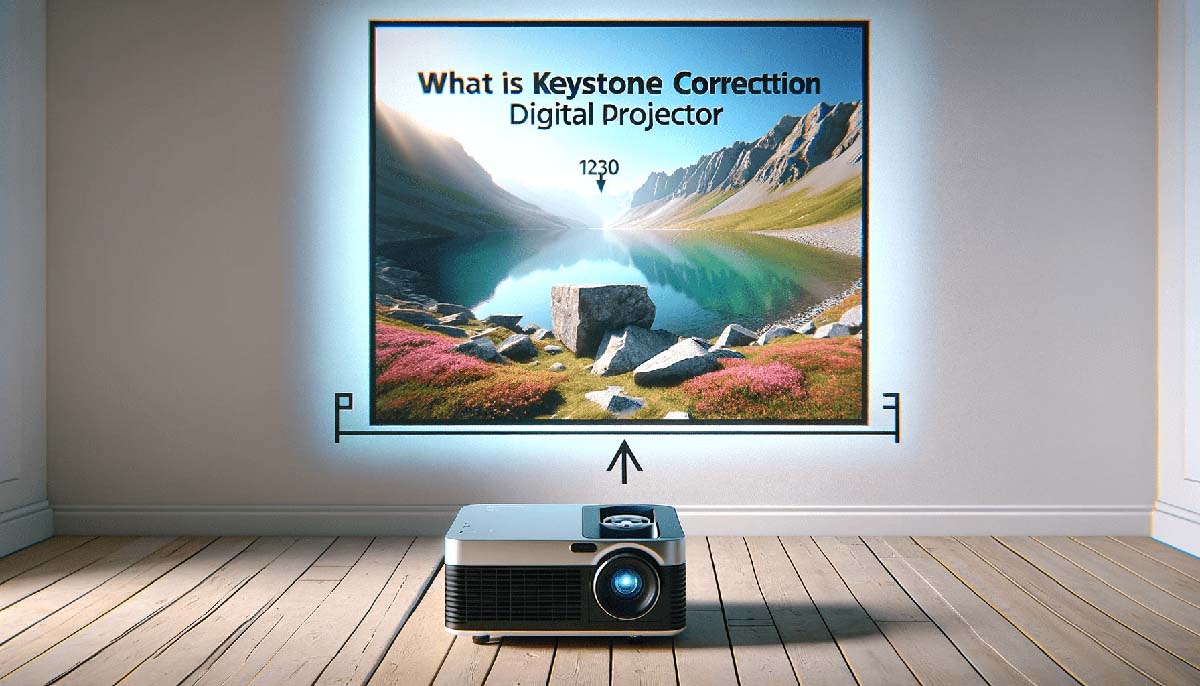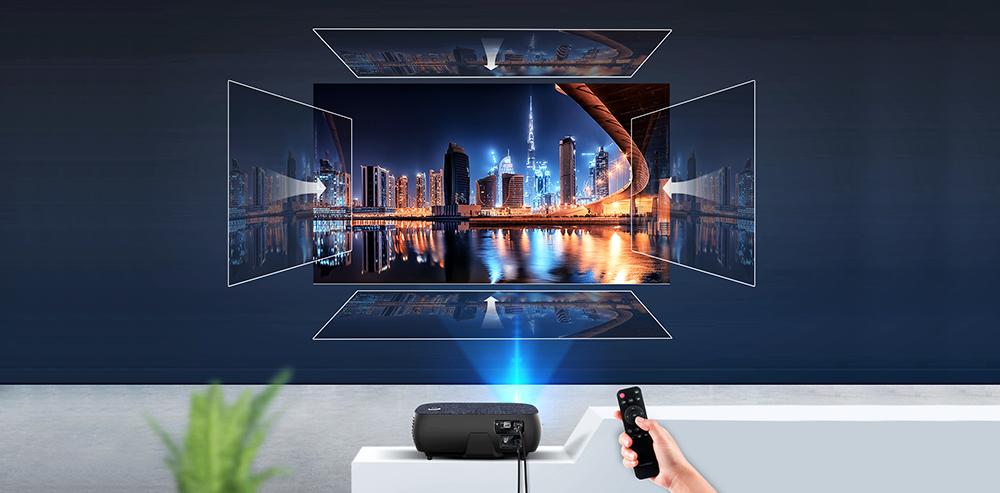What is Keystone Correction
When it comes to the world of digital projection, a critical aspect that often goes unnoticed is the phenomenon of keystone distortion. This distortion, characterized by a trapezoidal deformation of the projected image, is a common issue encountered when the projector is not positioned perpendicular to the screen.
Keystone correction is the technological response to this challenge, a feature increasingly incorporated in modern projectors to enhance image quality. This comprehensive guide aims to delve deeply into the nuances of keystone correction, exploring its operational principles, benefits, limitations, and essential considerations for choosing a projector equipped with this functionality.
Short answer: Keystone Correction is a feature in projectors that digitally adjusts the shape of an image to correct the distortion known as keystone effect. This distortion occurs when the projector is not perpendicular to the screen, causing the image to appear trapezoidal rather than rectangular. Keystone Correction compensates for this by digitally manipulating the image to restore its proper rectangular shape.
- Understanding Keystone Correction
- The Benefits and Limitations of Keystone Correction
- Choosing the Right Projector with Keystone Correction
- Types of Corrections
- FAQ about Keystone Correction
Understanding Keystone Correction

Keystone correction is a digital solution designed to rectify the image distortion caused by the angular misalignment of the projector. It works by digitally altering the image, compressing its wider side and stretching the narrower side, to restore a rectangular shape on the projection screen.
This correction is available in two forms: manual and automatic. Manual keystone correction requires user intervention to adjust the settings, which can be done through a variety of interfaces such as buttons, remote controls, or on-screen menus. Automatic keystone correction, on the other hand, employs sensors to detect the projector’s angle and autonomously makes the necessary adjustments.
An interesting alternative to keystone correction is the lens shift feature, which physically alters the position of the projector's lens to adjust the image's placement. Unlike keystone correction, lens shift does not digitally manipulate the image but rather changes the direction of the projected light. Although it offers more precision in image placement, lens shift is typically found in higher-end projectors due to its cost and complexity.
The Benefits and Limitations of Keystone Correction

Keystone correction offers a range of advantages, primarily in terms of projector placement flexibility. It allows for varied positioning of the projector without the need for precise alignment with the screen, simplifying the setup process. This is especially beneficial with automatic keystone correction, as it reduces the time and effort needed to achieve the perfect image alignment.
Additionally, by eliminating distortion, keystone correction significantly improves image quality and readability, which is particularly important for presentations containing text and detailed graphics.
However, keystone correction is not without its downsides. One of the primary limitations is the reduction in image resolution and brightness. As keystone correction involves digital modification of the image, it can lead to a loss in pixel count and a decrease in the overall light output.
This manipulation can also introduce visual artifacts such as jagged edges, blurriness, or color distortions, potentially impacting the overall image quality. Furthermore, keystone correction can alter the aspect ratio and geometry of the image, affecting its natural proportions and shape due to the digital stretching or compressing involved in the process.
Choosing the Right Projector with Keystone Correction

When selecting a projector with keystone correction, several factors need to be considered. The range of keystone correction, usually measured in degrees, indicates the level of image adjustment possible. A higher degree of correction offers more flexibility in projector placement but might compromise the image quality. The direction of keystone correction is another important factor.
Most projectors offer vertical keystone correction to correct distortions caused by vertical misalignments. Horizontal keystone correction is less common but can be beneficial in certain scenarios, such as when the projector is placed off-center.
The choice between manual and automatic keystone correction depends on individual preferences. Manual correction allows for greater control and precision but requires more user involvement. Automatic correction offers ease of use and speed, though it might not always provide the same level of accuracy. Some projectors offer both options, catering to different usage scenarios and user preferences.
Types of Corrections
Below is a detailed comparison table that contrasts the various types of corrections available in digital projectors:
| Feature | Keystone Correction | Lens Shift |
|---|---|---|
| Definition | A digital method to correct image distortion when a projector is not aligned perpendicularly to the screen. Adjusts the image digitally for a rectangular output. | A mechanical method for adjusting the position of the projected image by moving the projector's lens, changing the projection angle without digital alteration. |
| Types | - Manual Keystone Correction: User-adjusted through controls. - Automatic Keystone Correction: Adjusts automatically using sensors. |
N/A (Lens Shift is a single feature, varies in range and directionality across models). |
| Image Adjustment Method | Digitally adjusts the image by compressing or stretching to correct distortion, achieving a rectangular shape. | Mechanically adjusts the projection angle by moving the lens, changing the image's position without digital alteration. |
| Placement Flexibility | Allows flexible projector placement, digitally correcting from various angles. | Enhanced flexibility by enabling physical adjustment of the image position, avoiding digital alteration. |
| Impact on Image Quality | - May reduce resolution and brightness due to digital processing. - Potentially introduces artifacts like blurriness or jagged edges. |
Preserves original image quality, resolution, and brightness, with no digital alteration. |
| Setup Complexity | - Manual correction can be time-intensive. - Automatic correction simplifies and speeds up setup. |
Setup ease depends on projector design and user interface, generally straightforward. |
| Cost Implications | More affordable, standard in many projectors. | Typically found in high-end, more expensive projectors due to mechanical complexity. |
| Ideal Use Cases | Suitable for environments with limited placement options where minor image quality compromises are acceptable. | Best for settings where maintaining original image quality is crucial, offering precise control over image placement without quality loss. |
FAQ about Keystone Correction
Here are some frequently asked questions about Keystone Correction:
How do I set up keystone correction on my projector?
The setup process may vary depending on the model and brand of your projector, but generally, you can follow these steps:
- Place the projector on a flat surface or mount it on the ceiling, and connect it to the power source and the video source;
- Turn on the projector and aim it at the projection surface. Make sure the projector is as perpendicular to the surface as possible, and adjust the zoom and focus if needed;
- Check the shape of the projected image. If it is not perfectly rectangular, you may need to use keystone correction;
- Locate the keystone correction buttons or menu on the projector or the remote control. Some projectors may have separate buttons for vertical and horizontal keystone correction, while others may have a single button that toggles between the two directions;
- Press the keystone correction buttons or use the arrow keys to adjust the image until it appears rectangular. You may need to adjust the zoom and focus again after using keystone correction;
- Alternatively, some projectors may have an automatic keystone correction feature, which uses sensors to detect and correct the distortion without user input. You can activate this feature by pressing a button or selecting an option on the menu.
How does keystone correction affect the image quality?
Keystone correction affects the image quality by digitally modifying the image and reducing the number of pixels and the amount of light that reach the screen. This can result in a loss of resolution and brightness, as well as artifacts and noise, such as jagged edges, blurriness, or color distortion.
The more you use keystone correction, the more noticeable these effects will be. Therefore, you should use keystone correction sparingly and only when necessary, and try to minimize the distortion by placing the projector as perpendicular to the surface as possible.
What are the cons of keystone correction?
Keystone correction has cons that you should consider before using it. Here are some of them:
- It reduces the image resolution and brightness, as it digitally modifies the image and reduces the number of pixels and the amount of light that reach the screen;
- It can introduce artifacts and noise, such as jagged edges, blurriness, or color distortion, as it digitally processes the image and affects its quality;
- It can affect the aspect ratio and geometry of the image, as it digitally stretches or compresses the image and changes its shape and proportions.
What is Keystone Correction: Conclusion

Keystone correction is a significant feature in the realm of digital projectors, facilitating the achievement of a perfectly rectangular image in situations where projector alignment is less than ideal. By understanding the principles behind keystone correction, its advantages, and its limitations, users can make more informed decisions when selecting a projector.
The key lies in balancing the benefits of flexibility and image quality with the potential drawbacks in resolution and image integrity. By considering factors such as the degree, direction, and type of keystone correction, users can select a projector that best fits their specific needs and enhances their projection experience.
In summary, keystone correction stands as a testament to the evolving capabilities of digital projection technology, offering users a blend of convenience, flexibility, and enhanced visual quality.
You may also like:
